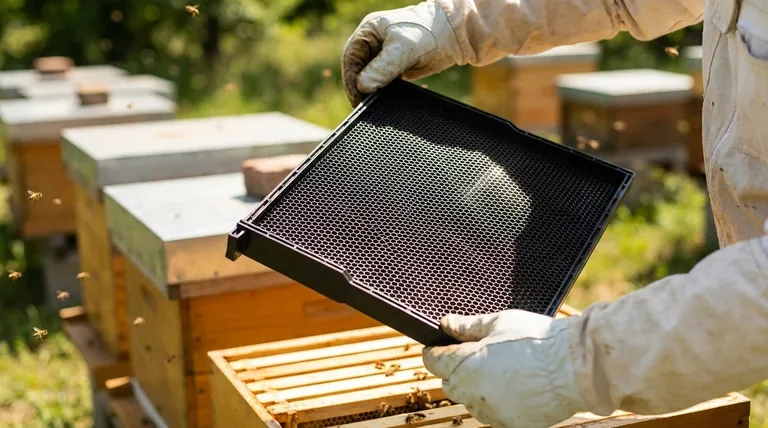Regularly renewing your beehive combs is a critical practice for maintaining hive hygiene and ensuring the long-term health of your bee colony. Over time, brood combs become dark and contaminated with the residues of hatched cocoons. This accumulation shrinks the size of the comb cells, which in turn leads to the development of smaller, more fragile bees, ultimately weakening the entire colony.
Think of comb renewal not as a chore, but as a fundamental reset for your colony's health. Old, dark comb acts as a slow-growing disease vector and a physical constraint, reducing bee vitality and increasing the hive's vulnerability.

The Hidden Dangers of Old Comb
The comb is the heart of the hive, serving as its nursery, pantry, and communication network. When this core structure degrades, the entire colony suffers from a cascade of negative effects.
A Reservoir for Pests and Pathogens
With each generation of brood raised, old cocoon linings, shed larval skins, and other residues are left behind in the cells. This dark, organic matter can become a perfect breeding ground for pathogens.
Old comb can harbor the spores of diseases and the eggs of pests. While a strong colony can often manage these threats, aging comb gives these antagonists a permanent foothold inside the hive, increasing the overall stress on the bees.
The Problem of Shrinking Cells
The most direct physical consequence of old comb is the gradual reduction in cell diameter. Each new layer of cocoon silk left by a hatched bee makes the cell infinitesimally smaller.
After dozens of brood cycles, this effect becomes significant. The internal volume of the hexagonal cells is physically reduced, leaving less space for the next developing larva to grow.
The Vicious Cycle of Smaller Bees
A bee's adult size is largely determined by the space it has to develop during its larval and pupal stages. When raised in smaller cells, the resulting adult bees are physically smaller.
These smaller bees are less robust. They have a shorter lifespan, reduced foraging capacity, and lower overall productivity. A colony populated by progressively smaller bees becomes weaker, less resilient to stress, and less efficient at gathering nectar and pollen.
Understanding the Trade-offs
While the benefits are clear, rotating out old comb is an active management decision that involves a cost-benefit analysis for both the beekeeper and the bees.
The Cost: Beekeeper Effort
Removing and replacing frames requires time, labor, and the cost of new frames and foundation. It is an intervention that must be planned and executed carefully.
The Cost: Bee Energy
Bees must consume a significant amount of honey to produce the beeswax needed to draw out new comb. For every pound of wax they create, bees may consume six to eight pounds of honey.
This is a major energy expenditure for the colony. A beekeeper must ensure comb replacement is done when nectar resources are available so that it doesn't deplete the colony's critical winter stores.
The Benefit: A Resilient, Productive Colony
The trade-off is an investment in the future. The short-term energy cost to the bees is repaid with the long-term benefits of a healthier, more vigorous, and more productive colony that is better equipped to fight disease and produce a surplus of honey.
Making the Right Choice for Your Goal
A systematic approach to comb rotation is the best strategy. Aim to replace about 20-30% of your brood frames each year, ensuring no comb remains in the brood chamber for more than four to five years.
- If your primary focus is colony health and disease prevention: A strict annual rotation is non-negotiable. This is the single best preventative action you can take to disrupt pest and disease cycles.
- If your primary focus is maximizing honey production: Renewing comb ensures you have a population of large, robust, and highly productive forager bees.
- If your primary focus is low-intervention beekeeping: Even for a hands-off approach, a slow rotation is vital for the colony's long-term sustainability. Failure to do so will likely lead to the colony's eventual decline.
By managing your combs proactively, you are not just maintaining a hive; you are cultivating a thriving, resilient colony for years to come.
Summary Table:
| Consequence of Old Comb | Impact on the Colony |
|---|---|
| Accumulation of Pathogens | Increased risk of disease, higher colony stress. |
| Shrinking Cell Size | Smaller, weaker bees with shorter lifespans. |
| Reduced Foraging Capacity | Lower honey production and pollination efficiency. |
| Overall Colony Weakening | Less resilience to pests, pathogens, and environmental stress. |
Equip your apiary for success with HONESTBEE.
Regular comb renewal is a cornerstone of modern, sustainable beekeeping. To execute this practice effectively, you need a reliable supply of high-quality frames and foundation. HONESTBEE supplies commercial apiaries and beekeeping equipment distributors with the durable, bee-friendly supplies necessary to maintain healthy, productive hives season after season.
Invest in your colony's future. Contact HONESTBEE today to discuss your wholesale needs and ensure your beekeeping operation is built on a solid foundation.
Visual Guide

Related Products
- Plastic Bee Frame Beekeeping Hive Frames for Wholesale
- Assembled Wooden Bee Frames with Beeswax Foundation Ready to Use by HONESTBEE
- HONESTBEE Wired and Assembled Wooden Bee Frames Foundation for a Thriving Hive
- Wooden Bee Brush with Triple Row Artificial Fiber for Beekeeping
- Professional 500g Sectional Comb Honey Frame System for Beekeeping
People Also Ask
- What are the differences between wooden and plastic frames in beehives? Choose the Best for Your Apiary
- What is a general rule for beekeepers with many hives regarding frame choice? Maximize Efficiency with Plastic Frames
- Can beekeepers switch between wooden and plastic frames? Optimize Your Hive's Performance
- Are plastic bee hive frames good? A Guide to Modern Durability vs. Natural Appeal
- Are plastic frames good? Boost Apiary Efficiency with Durable, Pest-Resistant Frames



















